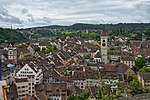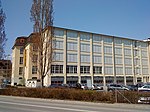Schaffhausen massacre
1401 in Europe14th-century massacres14th century in SwitzerlandAntisemitism in SwitzerlandJewish Swiss history ... and 2 more
Medieval anti-Jewish pogromsSchaffhausen

The Schaffhausen massacre was an anti-Semitic episode in Schaffhausen, in present-day Switzerland, which occurred in 1401. An episode of antisemitism had already occurred in Schaffhausen 52 years prior, when the local Jews were accused of well poisoning and burned alive on 22 February 1349. On this occasion, the Jews were accused of the murder of a four-year-old boy, Konrad Lori from Diessenhofen. "Confessions" were obtained from them under torture, and on 25 June 1401 they were executed by burning. Today, there is a plaque in Schaffhausen, commemorating the suffering of the Schaffhausen Jews in the Middle Ages.
Excerpt from the Wikipedia article Schaffhausen massacre (License: CC BY-SA 3.0, Authors, Images).Schaffhausen massacre
Spitalstrasse,
Geographical coordinates (GPS) Address Nearby Places Show on map
Geographical coordinates (GPS)
| Latitude | Longitude |
|---|---|
| N 47.7 ° | E 8.6333333333333 ° |
Address
Spitalstrasse 27
8200 , Emmersberg
Schaffhausen, Switzerland
Open on Google Maps









